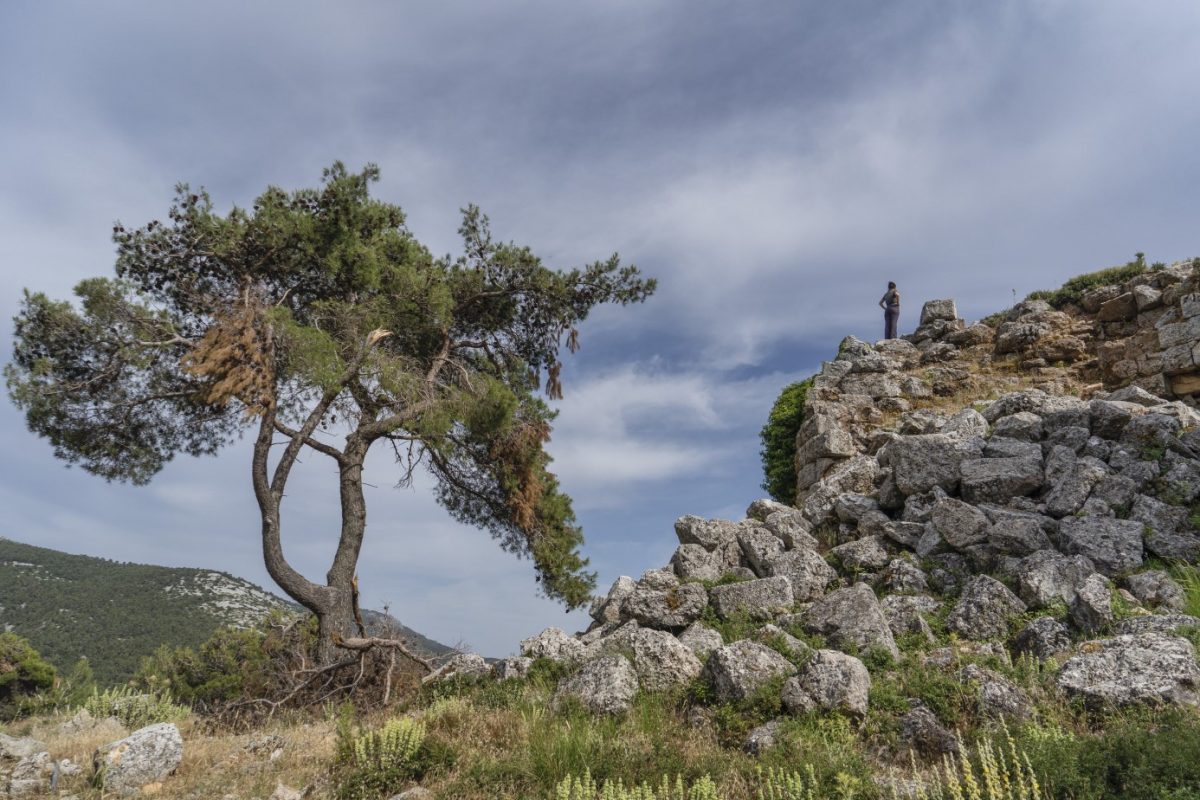“Come, take some more, we have a lot. We picked them at Tatoi.” The generous hand of a hiker offers us a plastic container full of pink-red berries.
She and her husband decided to take a walk on the highest mountain in the Attica region (1,413 m) on a Monday at noon.
The veteran walkers are taking a rest in the courtyard of Aghios Petros church.
He is sleeping on a chair with his feet up on a kerb while she is giving us the basic information on Mola (a beautiful location with picnic tables) and on how to get to Mesiano Nero.
She takes a look at our shoes and says: “You’re wearing hiking shoes, that’s fine, but you with the All Stars, you might slip.”
She offers us her delicious berries once more and we part ways.

© Perikles Merakos

© Perikles Merakos
The Mesiano Nero fountain is not very far from Mola: They are at a 4-minute drive or 16-minute walk from each other.
We choose the easy solution (driving), park our car at the exact point beyond which you are not allowed to drive and, after a short walk, we arrive at Mesiano Nero.
Yes, the fountain has water, but summer water, delicately flowing in a nearly unperceivable hum.
The small kiosk with the beautiful view is located a short walk up from the fountain; it is a great spot for a picnic away from the sun.
Suddenly, a young woman emerges on foot from the path; she is rather inexperienced, but tremendously enthusiastic at the fact that she can get out of her house at last, after the martyrdom of lockdown.
Her name? “Amanda. I’m from California. My husband is Greek and he often comes to Parnitha.”
Have a nice walk, Amanda!

© Perikles Merakos
Our journey continues in this way. At every stop we make, we encounter someone, either a mountain regular or a passerby, who can lighten or spoil your mood simply with their attitude and words. The veteran walkers and Amanda were pleasant encounters.
The ranger outside Aghia Triada was an unexpected one: At first, our talk revolves around the white church that has a courtyard filled with flower pots and is part of Petraki monastery. So far, so good.
Things get a bit more complicated as we tackle the subject of a remote building in Parnitha, known as the Papadopoulou villa or refuge.
“I read in a hiking guide that it was the former dictator’s illegally built villa,” I say, and ask him if it’s true. “What villa? What dictator? What dictatorship?” is the gist of his answer.
I rather turn my attention to two – genuinely democratic – deer that are standing nearby looking at us with curiosity.

© Perikles Merakos
Fortunately, this experience is the forest’s only downer; the rest seem like good people, like Giannis, who is in charge of Bafi refuge.
Founded way back in 1937, in 2009 the shelter’s roof caught fire and most of the building burned down.
It was renovated in a way that smoothly blends in with the landscape, and has a paved courtyard and wooden railings.
Giannis gives us a mini tour in rooms “Parnitha,” “Ymittos” and “Penteli” (in honor of Attica’s three great mountains) and tells us about the forest:
“I love it as much as I love my yard and I want it to be kept clean.” He focuses on the litter problem and reminds us that Parnitha is not just a mountain, it is also a national park, which means it must be treated with the uttermost respect. You should take back with you everything that you bring there (snacks, drinks, etc.).
The journey continues in silence among oak, heather, fir, willow and pine. Encounters are now made with gray and green lizards or with human figures – like the sculptures made from burned tree trunks by sculptor Spyridon Dasiotis opposite Parnitha’s old sanatorium, in a site called “The Park of Souls.”

© Perikles Merakos
Last stop: Frourio Filis. This ancient, 4th-century BC fortress, which remains sweet in its abandonment, has something of the megalithic beauty of Mycenae.
We begin carefully following the path on the left-hand side of the fortress, one in hiking shoes, the other in All Stars, and we enter it, finding a plateau full of wheat.
The gate reveals the mountain’s forested slopes at first, the sparsely populated suburbs a bit further and the dense city mass on the horizon.
So long, Parnitha! It wasn’t always easy, but we had a great time.











